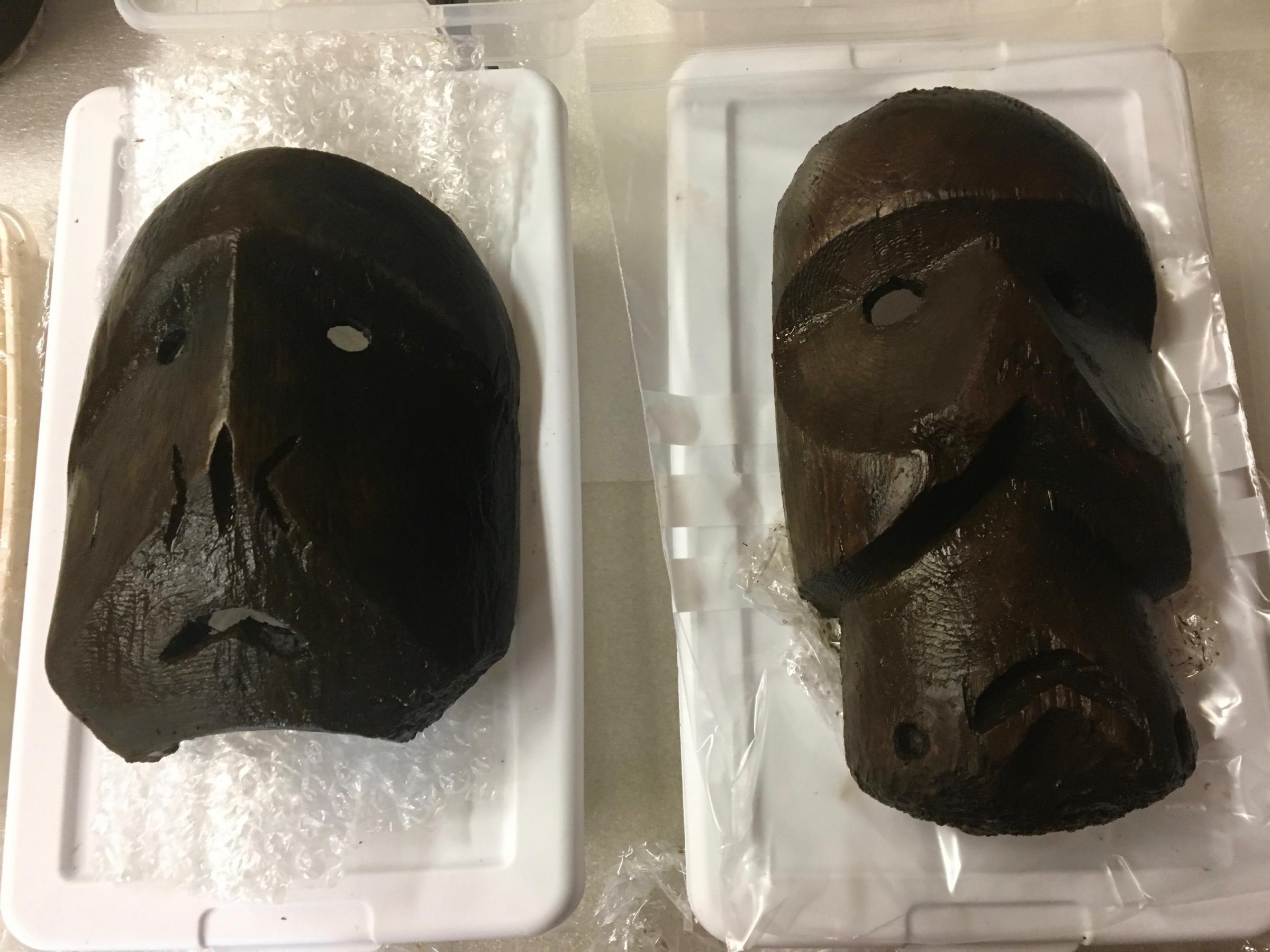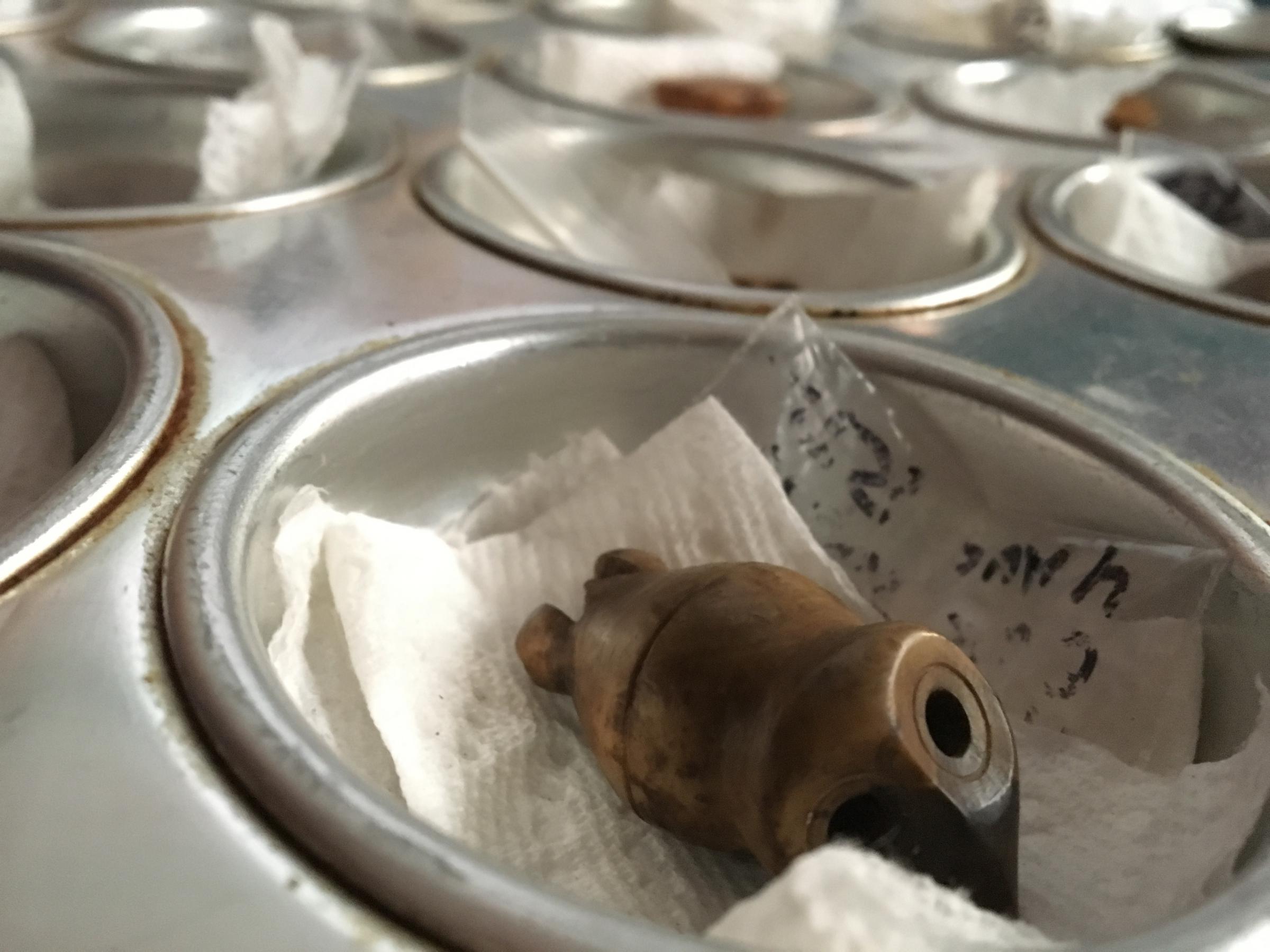
It’s been eight years since a small team began excavating an ancient village outside of Quinhagak. Now archaeologists and tribal leaders are saving what they can before the site washes away. This summer, volunteers worked to recover what they could. Over the years, the artifacts they’ve found have given new insight into Yup’ik history during a time of war.
It’s a windy day in Quinhagak and a small group of elders, community leaders, and Delta professionals are crowded around a table in the village’s old preschool. It was recently revamped and is now the local museum. Archaeologist Rick Knecht explains what we’re looking at; the table is lined with rows of long, wooden masks.
“These are the oldest Yup’ik masks in the world right now,” Knecht said. “These things are from about the 1500s, so about 500 years old.”
A metal pan next to the masks is piled with earrings, tattoo needles, arrowheads, and children’s dolls. There’s also an immaculately carved ivory owl. “We have no idea how they were able to do this,” Knecht said, pointing to the owl’s perfectly circular eyes. “Even now, our carvers can’t reproduce it with dremels.”
These are just some of the artifacts that archaeologists have found at Nunalleq, the excavation of an ancient Yup’ik village on the coast outside of Quinhagak. The artifacts are up to 700 years old and they’ve all been immaculately preserved in the region’s permafrost.
Knecht first visited Nunalleq in 2009, when local corporation president Warren Jones sent him pictures of several artifacts the Quinhagak residents had discovered along the beach outside of town. And as is the case with other sites along Alaska’s coast, Nunalleq’s artifacts might never have been unearthed if the permafrost hadn’t started thawing. Now that it’s getting slushy, Knecht says that his team is in a race against time.
In a worst case scenario, the site could be swept away this November. “We could lose the whole thing this winter,” Knecht said.
Knecht said that the site will most likely be around for another five years.

Nunalleq is a short hike from Quinhagak. At the site, about a dozen volunteers are squatting in a shallow, rectangular pit, carefully digging with trowels and buckets. Two large red fans are set up at one end to keep away the no-see-ums.
According to Knecht, over the summer the dig’s volunteers each discovered an average of 100-200 artifacts a day. Over the years the community’s found something else in the ice at Nunalleq – the reason that the village was abandoned hundreds of years ago. Archaeologists found burnt sod and baskets, and then a series of skeletons.
“Up on that roof deposit where the ashes were, it was full of arrow points. Just full of them,” Knecht said. “The house must’ve looked like a pin cushion.”
The people who lived in Nunalleq were killed in a massacre.
“We could tell that they were dragged out of the house while alive,” Knecht said. “They’d been executed face down in the mud.”
This killing is a well-known incident in the Bow and Arrows War that was preserved through the centuries in Yup’ik history. According to oral tradition, women in the village sent their children running to their enemies in hopes that they would be adopted and spared, but the children were slaughtered along with everyone else. The archaeologists found the children’s bodies among the remains.
The carnage that was found here at Nunalleq is the first archaeological evidence of the Bow and Arrows War, and it provides the famous massacre with its first date. Knecht said it happened around 1670 — long before the area was colonized.
Excavating this site was controversial. Elders in Quinhagak knew that an ancient village was buried on the coastline outside of town, but it goes against Yup’ik tradition to disturb a sacred site. Community leaders decided to excavate when they saw that their history was being washed away.
Mary Beaver and Katie Green are sitting at the edge of the dig site, watching as a volunteer recovers an arrowhead. Both women are elders, from St. Mary’s and Bethel respectively. I think they wanted to be found, Green says of the villagers of Nunalleq, and Beaver agrees.
“They were just like survivors here,” Beaver said. “And I feel so proud of them, how they survived.”
Warren Jones watches the dig from a distance. It’s been something of a boon for Quinhagak. Jones is the head of Quinhagak’s village corporation, which owns all of the discoveries from the Nunalleq site. Many of artifacts are being preserved and cataloged at the University of Aberdeen right now, but they’re scheduled to be sent back to Quinhagak next year, where they will be displayed in the old pre-school building being transformed into a proper museum. This will be the first museum with a significant collection of some of the world’s oldest Yup’ik artifacts located in a remote village in an economically impoverished region of Alaska.
Though they haven’t discovered a body at Nunalleq in a while, when they were unearthing the massacre Jones says that they came up with a system.
“We talked to the elders about what to do, and they said do a little burial,” he said. “So every time we found skeletons or bones, we asked our manager to take them out to the site a little further away from here, say a little prayer, and bury them.”
“It took hundreds of years, but now they’re safe at the ground, not too far from their village,” Jones said. “They’re finally at rest.”
Artifacts are appearing along the coast of Western Alaska as the planet warms. If you live by the sea and you happen to find one, Rick Knecht recommends that you wrap it in saran wrap, put it in your fridge, and then contact Steve Street at the Association of Village Council Presidents, at 907-543-7355.




